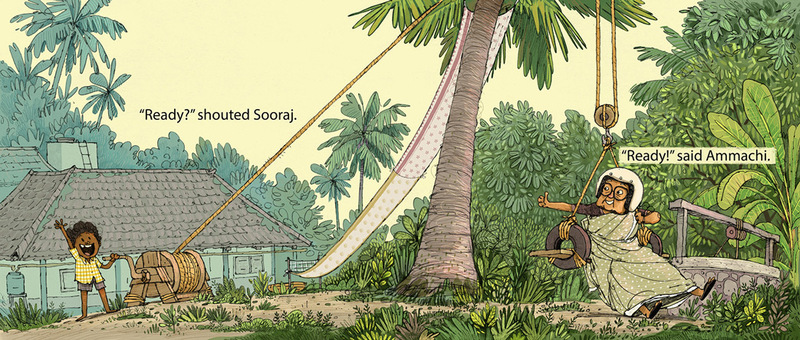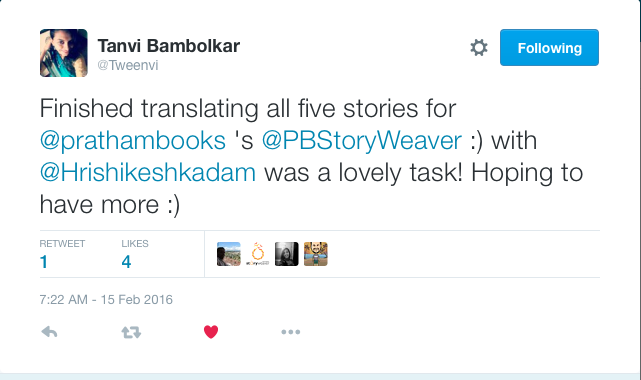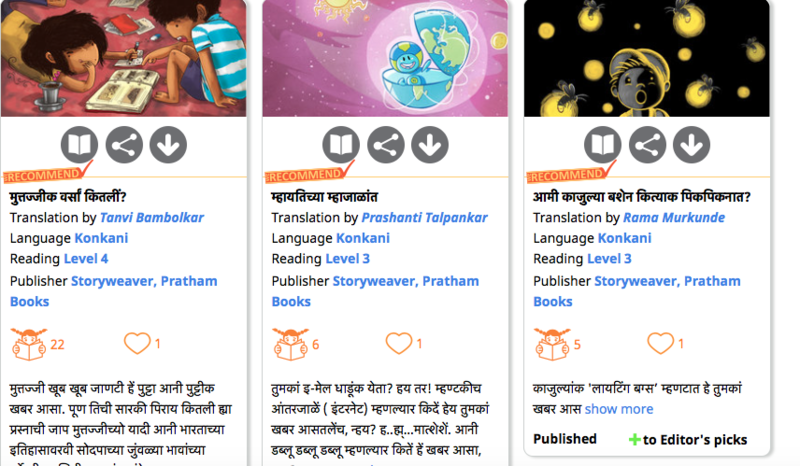ಪುಟ್ಟಿ ಮತ್ತು ಪುಸ್ತಕಗಳು/ Putti and Books
Posted by Remya Padmadas on October 09, 2019"Translations are equivalent to communicating science" opines Kollegala Sharma, Science Communicator, Senior principal scientist at CFTRI. Translations are just like reciting stories. Stories are an effective source of learning, given their vast scope and structure. Science itself is a type of language, and so science communication and translation for kids face similar challenges. Below is a short story in Kannada about two sisters. Putti is a young girl who is curious to know things that she sees around her. When she sees a picture book, she is curious about mammals like the platypus, but her sister finds it difficult to explain this to Putti as these words are unfamiliar to the toddler’s experience and environment. The story depicts the difficulties of translating science concepts.
ಅನುವಾದ ಅನ್ನುವುದು ಹೀಗೇ. ಮಕ್ಕಳಿಗೆ ಕಥೆ ಹೇಳಿದ ಹಾಗೆ. ಅವರಿಗೆ ತಿಳಿಯದ್ದನ್ನು ತಿಳಿಸುವ ರೀತಿಯಲ್ಲೇ, ಬೇರೆ ಬಾಷೆಯದ್ದನ್ನೂ ನಮ್ಮ ಓದುಗರಿಗೆ ತಿಳಿಸಬೇಕಾಗುತ್ತದೆ. ವಿಜ್ಞಾನವೂ ಬೇರೆ ಭಾಷೆಯೇ ಆಗಿದ್ದರಿಂದ ಇದೇ ಕಥೆ ಅಲ್ಲಿಯೂ ಸಲ್ಲುತ್ತದೆ.
ಧೊಪ್…
“ಏನೇ ಅದು ಸದ್ದು?” ಅಮ್ಮ ಅಡಿಗೆ ಮನೆಯಿಂದಲೇ ಕೂಗಿದಳು
ಅಯ್ಯೋ. ಇನ್ನು ಅಕ್ಕ, ಅಮ್ಮ ಇಬ್ಬರೂ ಬರುತ್ತಾರೆ. ಅಷ್ಟರಲ್ಲಿ ಇದೆಲ್ಲ ಸರಿ ಮಾಡಬೇಕು. ಪುಟ್ಟಿ ಕೆಳಗೆ ಬಿದ್ದ ಚೀಲವನ್ನು ನೋಡಿದಳು.
ಅಯ್ಯೋ. ಇದರಲ್ಲಿ ಚಾಕಲೇಟು ಇಲ್ಲ. ಬರೀ ಪುಸ್ತಕ.
ಶಾಲೆಯಿಂದ ಬಂದ ಅಕ್ಕ ಚೀಲವನ್ನು ಬಿಸಾಡದೆ ಮೇಜಿನ ಮೇಲೆ ಇಟ್ಟಳಲ್ಲ. ಆಗಲೇ ಅದರಲ್ಲೇನೋ ಗುಟ್ಟು ಇರಬೇಕು ಅಂತ ಪುಟ್ಟಿಗೆ ಅನಿಸಿತ್ತು. ಯಾರಾದರೂ ಹುಟ್ಟಿದ ಹಬ್ಬಕ್ಕೆ ಕೊಟ್ಟ ಚಾಕಲೇಟು ಇರಬಹುದು ಅಂದುಕೊಂಡಿದ್ದಳು. ಆದರೆ…
“ಓಹೋ. ಎಷ್ಟೊಂದು ಪುಸ್ತಕ. ಎಷ್ಟೊಂದು ಬಣ್ಣ.”
“ಏಯ್ ಪುಟ್ಟಿ. ಅದು ನಂದು ಪುಸ್ತಕ. ಮುಟ್ಟಬೇಡ.” ಬೆನ್ನ ಹಿಂದಿನಿಂದ ಅಕ್ಕ ಹೇಳಿದಳು.
“ಪುಟ್ಟಿ. ಅಕ್ಕನ ಚೀಲ ಮುಟ್ಟಬೇಡ ಅಂತ ಹೇಳಿದ್ದೆ. ಮೈ ಮೇಲೆ ಬಿದ್ದಿದ್ದರೆ?ʼ ಅಮ್ಮ ಕೂಡ ಬೈದಳು.
“ಅಕ್ಕ, ಅಕ್ಕ. ಪುಸ್ತಕ ಕೊಡೇ? ನಾನೂ ನೋಡ್ತೀನಿ.”
“ಏಯ್ ಹೋಗೇ. ನಿಂಗೆ ಓದಕ್ಕೆ ಬರೆಯಕ್ಕೆ ಬರತ್ತಾ? ದೊಡ್ಡವಳಾಗು ಆಮೇಲೆ ಕೊಡ್ತೀನಿ.”
ಈ ದೊಡ್ಡವರೆಲ್ಲ ಹೀಗೇ. ದೊಡ್ಡವರಷ್ಟೆ ಪುಸ್ತಕ ಓದಬಹುದು ಅಂದುಕೊಂಡಿದ್ದಾರೆ. ನಂಗೆ ಅಕ್ಷರ ಗೊತ್ತಿಲ್ಲದಿದ್ದರೆ ಏನಂತೆ? ಈ ಬಣ್ಣ, ಬಣ್ಣದ ಚಿತ್ರ ನೋಡಬಹುದು.
“ಅಕ್ಕ. ಚಿತ್ರ ನೋಡ್ತೀನಿ ಕೊಡೇ?”
“ಬೇಡ ಪುಟ್ಟಿ. ಅದು ಶಾಲೆಯ ಪುಸ್ತಕ. ಆಮೇಲೆ ನೀನು ಹರಿದು ಹಾಕಿದರೆ. ದೊಡ್ಡವಳಾದ ಮೇಲೆ ನಿಂಗೂ ಇವೆಲ್ಲ ಸಿಗುತ್ತೆ.” ಈಗ ಅಮ್ಮನ ಸರದಿ.
“ಪರವಾಗಿಲ್ಲ ಅಮ್ಮ. ನಾನು ಬರೇ ಚಿತ್ರ ನೋಡ್ತೀನಿ.”
“ಹೋಗೇ. ಹೋಗೇ. ಅದು ಇಂಗ್ಲೀಷು ಬುಕ್ಕು! ಇದು ದೊಡ್ಡ ಮಕ್ಕಳ ಪುಸ್ತಕ ಗೊತ್ತಾ? ನಿಂಗೆ ಅರ್ಥ ಆಗಲ್ಲ.”
“ಇಲ್ಲ ಅಕ್ಕ. ನೋಡು. ಇದು ನಾಯಿ. ಇದು ಮಂಚ. ನಾಯಿ ಮಂಚದ ಕೆಳಗೆ ಏನನ್ನೋ ಹುಡುಕುತ್ತಾ ಇದೆ. ಅಲ್ಲವಾ? ನೋಡಿದ್ಯಾ?”
“ಓಹೋಹೋಹೋ. ಓದಕ್ಕೆ ಬರತ್ತಂತೆ. ನಾಯಿ, ಮಂಚ ಸರಿ. ಇದು ಏನು ಹೇಳ್ತೀಯಾ?”
“ಯಾವುದು? ಇದಾ?... ಇದು… ಇದು…”
“ನೋಡು. ನೀನು ಇನ್ನೂ ಚಿಕ್ಕವಳು. ಚಿತ್ರ ನೋಡಕ್ಕೂ ಬರಲ್ಲ.”
“ಇಲ್ಲ ಅಕ್ಕ. ಅದು ಏನೋ ನಾನು ನೋಡಿಲ್ಲ. ಅದು ಏನದು ಅಕ್ಕಾ?ʼ
“ನಾನೂ ನೋಡಿಲ್ಲ. ಆದರೆ ಅದು ಏನು ಅಂತ ನಂಗೆ ಗೊತ್ತು. ಅದಿಕ್ಕೆ ಹೇಳಿದ್ದು ನೀನು ದೊಡ್ಡವಳಾಗಬೇಕು ಅಂತ.”
“ನೀನೂ ನೋಡಿಲ್ಲವಾ? ಮತ್ತೆ ಅದು ಹೆಂಗೆ ನಿಂಗೆ ಗೊತ್ತಾಯಿತು? ಏನದು?”
“ಅದು ಪ್ಲಾಟಿಪಸ್ ಅಂತ. ನಮ್ಮ ಟೀಚರ್ರು ಅದರ ಬಗ್ಗೆ ಹೇಳಿಕೊಟ್ಟಿದ್ದರು.”
“ಓ. ನಾನು ನಾಯಿ ಅಂದುಕೊಂಡಿದ್ದೆ. ಈಗೇನಂತೆ. ಪ್ಲಾಟಿಪಸ್ ಅಂತ ಹೆಸರು ಅಷ್ಟೆ ತಾನೇ. ಆದರೆ ಅದು ಈಗ ಮಂಚದ ಕೆಳಗೇ ಇದೆಯಲ್ಲ.”
“ಆದರೂ ಪ್ಲಾಟಿಪಸ್ಸೇ ಬೇರೆ, ನಾಯೀನೇ ಬೇರೆ ಗೊತ್ತಾ?, ಅಕ್ಕ ಹೇಳಿದಳು.
“ಅದೇನೋ. ಎರಡೂ ಪ್ರಾಣಿಗಳು ಅಷ್ಟೆ.” ಎಂದಳು ಪುಟ್ಟಿ.
ಹಂಗೆಲ್ಲ ಗೊತ್ತಿಲ್ಲದ ವಿಷಯ ಓದೋದು ಕಷ್ಟ ಗೊತ್ತಾ? ಅದಿಕ್ಕೆ ಮೊನ್ನೆ ನಮ್ಮ ಟೀಚರ್ರು ಬೈದಿದ್ದರು.”
“ಟೀಚರ್ರು ಬೈದರಾ? ಯಾಕೆ? ನೀನೇನು ಮಾಡಿದೆ?” ಅಮ್ಮ ಅಕ್ಕನನ್ನು ಕೇಳಿದರು.
“ಏನಿಲ್ಲ. ಪ್ಲಾಟಿಪಸ್ ಹೆಸರನ್ನ ಬರಿ ಅಂತ ಡಿಕ್ಟೇಶನ್ ಕೊಟ್ಟಿದ್ದರು. ನಾನು ತಪ್ಪಾಗಿ ಬರೆದಿದ್ದೆ.”
“ಯಾಕೆ? ಅವತ್ತು ನಾನೂ ಹೇಳಿಕೊಟ್ಟಿದ್ದೆನಲ್ಲ? ಮರೆತು ಹೋಯಿತಾ?” ಅಮ್ಮ ಕೇಳಿದರು.
“ಇಲ್ಲಮ್ಮ. ಮರೀಲಿಲ್ಲ. ಇಂಗ್ಲೀಷಲ್ಲಿ ಚೆನ್ನಾಗಿ ಗೊತ್ತು. ಪಿ ಎಲ್ ಎ ಟಿ ವೈ ಪಿ ಯು ಎಸ್ ಅಂತ. ಆದರೆ ಕನ್ನಡದಲ್ಲಿ ಬರಿ ಅಂದರು. ಬರೆದಿದ್ದು ತಪ್ಪು ಅಂದರು.”
“ಓಹೋ. ಸರಿ ಬಿಡು. ನಿಂಗೆ ಒತ್ತಕ್ಷರ ಇನ್ನೂ ಕಲಿಸಿಲ್ಲ. ಅದು ಹೇಗೆ ಅದನ್ನ ಬರೆಯಕ್ಕೆ ಆಗತ್ತೆ?” ಅಮ್ಮ ಹೇಳಿದರು.
“ಅಲ್ಲಮ್ಮ. ಅಕ್ಕ ಇಂಗ್ಲೀಷಲ್ಲಿ ಬರೀತಾಳೆ. ಕನ್ನಡದಲ್ಲಿ ಯಾಕೆ ತಪ್ಪು ಮಾಡ್ತಾಳೆ?”
“ಪುಟ್ಟಿ ಅದೆಲ್ಲ ಗೊತ್ತಾಗಕ್ಕೆ ನೀನು ದೊಡ್ಡವಳಾಗಬೇಕು. ಕನ್ನಡದಲ್ಲಿ ಸ್ಪೆಲ್ಲಿಂಗು ಸ್ವಲ್ಪ ಕಷ್ಟ. ಇಂಗ್ಲೀಷಲ್ಲಿ ಹಾಗಲ್ಲ. ಅದಿಕ್ಕೆ ಇಂಗ್ಲೀಷು ಹೆಸರನ್ನ ಕನ್ನಡದಲ್ಲಿ ಬರೆಯೋದು ಕಷ್ಟ. “
“ಅಕ್ಕಾ ಅಕ್ಕಾ. ನಿಂಗೆ ಈ ಪುಸ್ತಕ ಓದಕ್ಕೆ ಬರತ್ತೆ ಅಲ್ಲವಾ? ನೀನೇ ಓದಿ ನಂಗೆ ಕಥೆ ಹೇಳ್ತೀಯಾ?”
“ಓ ಅದಕ್ಕೇನಂತೆ? ಹೇಳ್ತೀನಿ.” ಅಡ್ವೆಂಚರ್ಸ್ ಆಫ್ ಮಿರಿಂಡಾ – ದಿ ಪ್ಲಾಟಿಪಸ್.
“ಏಯ್ ಅಕ್ಕ. ನಂಗೆ ಅರ್ಥ ಆಗ್ಲಿಲ್ಲ. ಕನ್ನಡದಲ್ಲಿ ಹೇಳೇ?
“ಅದು ಹೇಗೆ ಹೇಳಲೇ ಪುಟ್ಟಿ. ಇದು ಇಂಗ್ಲೀಷು ಪುಸ್ತಕ.”
“ಅಕ್ಕ. ನೀನು ಓದಿದ್ದೀಯಲ್ಲ. ನಿಂಗೆ ಕಥೆ ಗೊತ್ತಿರತ್ತೆ. ಅದನ್ನೇ ಹೇಳೇ?
“ಏಯ್ ಹೋಗೇ. ಅದೇನು ಅಷ್ಟೊಂದು ಸುಲಭ ಅಂದುಕೊಂಡಿದ್ದೀಯಾ?”
“ ಅಕ್ಕ. ಪ್ಲೀಸ್ ಹೇಳೇ! ಯಾಕೆ ನಿಂಗೂ ಅರ್ಥ ಆಗಿಲ್ಲವಾ?”
“ಓ. ನಂಗೆ ಅರ್ಥ ಆಗಿದೆ. ಆದರೆ ಇದು ಇಂಗ್ಲೀಷು ಅಲ್ಲವಾ ನಿಂಗೆ ಗೊತ್ತಾಗಲ್ಲ ಅಂದೆ ಅಷ್ಟೆ. ಸರಿ ಹೇಳ್ತೀನಿ ಕೇಳು. ಇದು ಮಿರಿಂಡಾ ದಿ ಪ್ಲಾಟಿಪಸ್ಸಿನ ಸಾಹಸಗಳು.”
“ಮಿರಿಂಡಾ, ಪ್ಲಾಟಿಪಸ್ಸು, ಅದನ್ನೂ ಇಂಗ್ಲೀಷಲ್ಲಿ ಹೇಳಕ್ಕಾ?”
“ಅಯ್ಯೋ. ಅದು ಹೆಸರು ಕಣೇ. ಅವನ್ನ ಇಂಗ್ಲಿಷಲ್ಲಿ ಹೇಗೆ ಹೇಳೋದು?”
“ಸರಿ. ಆಮೇಲೆ?.”
“ಮಿರಿಂಡಾ ಒಂದು ಪ್ಲಾಟಿಪಸ್ಸು. ಪ್ಲಾಟಿಪಸ್ಸು ಅಂದರೆ ಗೊತ್ತಲ್ಲಾ? ಅದು ಒಂದು ಮ್ಯಾಮಲ್?”
“ಮ್ಯಾಮಲ್? ಹಂಗಂದ್ರೆ?ʼ
“ಹಂಗಂದ್ರೆ. ಹಂಗಂದ್ರೆ.. ಹಂಗಂದ್ರೆ… “
“ಅಕ್ಕಂಗೂ ಗೊತ್ತಿಲ್ಲ. ಅಕ್ಕಂಗೂ ಗೊತ್ತಿಲ್ಲ.”
“ಏಯ್. ಸುಮ್ನಿರೇ. ಗೊತ್ತಿಲ್ಲ ಅಂತಲ್ಲ. ಕನ್ನಡದಲ್ಲಿ ಏನಂತಾರೆ ಗೊತ್ತಿಲ್ಲ. ಮ್ಯಾಮಲ್ ಅಂದರೆ ಹಾಲು ಕುಡಿಸೋ ಪ್ರಾಣಿಗಳು ಅಂತ ನಮ್ಮ ಟೀಚರ್ರು ಹೇಳಿಕೊಟ್ಟಿದ್ದಾರೆ ಗೊತ್ತಾ?.. ಇರು ಅಮ್ಮನ್ನ ಕೇಳ್ತೀನಿ. ಅಮ್ಮಾ. ಅಮ್ಮ. ಮ್ಯಾಮಲ್ ಅಂದರೆ ಏನಮ್ಮಾ? ಅದೂ ಹೆಸರಾ?”
“ಮ್ಯಾಮಲ್ಲು ಅಂದರೆ ಸ್ತನಿ ಅಂತ ಮಗಳೇ. ಅದು ಗುಂಪಿನ ಹೆಸರು. “
“ಮತ್ತೆ ಹೆಸರನ್ನು ಹಾಗೇ ಇಡಬೇಕಲ್ಲವಾ?”
“ಇದು ಹೆಸರು ನಿಜ. ಆದರೆ ಇದು ಒಂದು ಗುಂಪಿನ ಹೆಸರು. ಇಂಥವರದ್ದು ಅಂತ ಇಲ್ಲ. ಅದಿಕ್ಕೆ ಇದನ್ನ ನಾವು ಕನ್ನಡದಲ್ಲಿ ಬೇರೆ ಹೆಸರಿಟ್ಟು ಕರೀಬಹುದು. ಸ್ತನಿ ಅಂತ ಅದಕ್ಕೆ ಹೇಳ್ತೀವಿ.”
“ಓಹೋ. ಗೊತ್ತಾಯಿತು.”
“ಸರಿ. ಪ್ಲಾಟಿಪಸ್ ಒಂದು ಸ್ತನಿ. ಅದು ಮೊಟ್ಟೆ ಇಡುತ್ತದೆ.”
“ಹೂಂ. ಗೊತ್ತಾಯಿತು. ಅದು ಈಗ ಏನನ್ನೋ ತಿನ್ನಕ್ಕೆ ಹೋಗ್ತಾ ಇದೆ ಅಲ್ಲವಾ?”
“ಪುಟ್ಟಿ. ಜಾಣೆ ಕಣೆ. ಅದು ಹೆಂಗೇ ಗೊತ್ತಾಯಿತು?”
“ಅಯ್ಯೋ ಅಕ್ಕಾ. ಈ ಚಿತ್ರ ನೋಡು. ಪಲಾಟಿಸ್ಸು ಆ ಪಾತ್ರೆ ಕಡೇನೇ ನೋಡ್ತಾ ಇದೆ. ಆ ಪಾತ್ರೇಲಿ ತಿಂಡಿ ಇದೆ ಅಲ್ಲವಾ?”
“ಪುಟ್ಟಿ. ಅದು ಪಲಾಟಿಸ್ಸು ಅಲ್ಲ. ಪ್ಲಾಟಿಪಸ್ಸು. ಆ ಪಾತ್ರೇಲಿ ಇರೋದು ಚೀಸು”
“ಪ..ಪಪ..ಪಲಾಆಆಆಟಿಪಸ್ಸು… ಸರೀನಾ… ಇಂಗ್ಲೀಷಲ್ಲಿ ಯಾಕಪ್ಪ ಅಷ್ಟೊಂದು ಕಷ್ಟದ ಹೆಸರು ಇಡ್ತಾರೆ.”
“ಪುಟ್ಟಿ. ಹೆಸರು ಕಷ್ಟ ಅಲ್ಲ. ನಿಂಗೆ ಓದಕ್ಕೆ ಬರಲ್ಲ. ನೋಡು ನಾನು ಓದಲ್ಲವಾ?”
“ಹೋಗಕ್ಕ. ನೀನು ದೊಡ್ಡವಳು. ಆಮೇಲೆ ಆ ಚೀಸು ಬೆಣ್ಣೇನಾ?”
“ಅಯ್ಯೋ ಪೆದ್ದಿ. ಚೀಸು ಬೆಣ್ಣೆ ಅಲ್ಲ. ಅದು ಚೀಸು.”
“ಆದ್ರೆ ಬೆಣ್ಣೆನೂ ಹಾಗೇ ಹಳದೀಗೆ ಇರುತ್ತೆ ಅಲ್ಲವಾ?”
“ಹೋಗೆ ಪೆದ್ದಿ. ನಿಂಗೆ ಏನೂ ಹೇಳಿಕೊಡಲ್ಲ. ಸುಮ್ಮನೆ ಪ್ರಶ್ನೆ ಕೇಳ್ತಾ ಇರ್ತೀಯಾ? ಅದು ಇಂಗ್ಲೀಷು ತಿಂಡಿ. ಅದನ್ನ ಚೀಸು ಅಂತಾರೆ. ಅದು ಬೆಣ್ಣೆ ಅಲ್ಲ.”
“ಊಊಊ… ಅಮ್ಮ. ಅಮ್ಮ. ಅಕ್ಕ ಪೆದ್ದಿ ಅಂದಳು.” ಪುಟ್ಟಿ ಅಳುತ್ತಾ ಓಡಿದಳು.
Do join the conversation by leaving your thoughts in the comments section below. You can also reach out to us through our social media channels: Facebook, Twitter and Instagram.
Be the first to comment.A New Set of STEM Books That Will Fascinate and Delight
Posted by Remya Padmadas on December 28, 2016Most of StoryWeaver's digital-first books explore STEM (Science, Technology, Engineering, Math) topics in interesting and fun ways. Some of you may remember some of our amazing STEM titles from last year: 'How Old is Muttajji?', 'Jadav and the Tree-Place', 'Up World, Down World', 'Dum Dum-a-Dum Biryani!', etc. We’re happy to announce that these are also being printed early next year!
“This year, we’ve tried to create books that are simpler than last year, based on conversations with our outreach partners. Simpler does not mean easier, of course, and in many ways it has been more challenging. Fortunately, we’ve been working closely with some of the finest editors, writers, illustrators, art directors and translators who have helped us create a set of wonderful books. While the aim of each book is to inform and educate, the idea is also to nurture the innate sense of wonder in children and in turn, encourage them to explore further,” shares Yamini Vijayan, who anchors content creation for StoryWeaver.
Exciting ideas through exciting partnerships
This year, we hope to widen the lens through which children look at the world around them, with stories that explore topics like space, types of houses, trash, seasonal food, subtraction, evolution, simple machines and even toilets!

From author-illustrator Rajiv Eipe's book on simple machines
These books have been created in collaboration with 4 Guest Editors and 2 Art Directors. Award-winning author Roopa Pai has steered the books on math, Bijal Vachharajani – a journalist who writes on nature and the environment – has given shape and form to the books on environment, author-illustrator Vinayak Varma, former Editor and Art Director of Brainwave Magazine, has helped create fun science books and author-editor Payal Dhar has made technology and engineering appealing to young minds. With illustrations being such an integral aspect of these books, we were keen to involve experts in the field and so these books have been art-directed by talented illustrators Kaveri Gopalakrishnan and Vinayak Varma. We’re excited to say that some of the most promising authors and illustrators have contributed to the creation of these 20 titles.

Priya Kuriyan brings Neema to life in vivid colours in 'What's Neema Eating Today?' by Bijal Vachharajani
In Math, we have books on subtraction, patterns of similarity and dissimilarity, division and estimation. Needless to say, all these have been explained through simple stories that show how we use math in our everyday lives and that it isn’t restricted to our textbooks alone. At Pratham Books, we have always realized how important it is to have conversations about the environment to children. This year, we have chosen to focus on trash, seasonal food, migration and earthquakes. Themes in science that we have decided to ‘storify’ are simple machines, virology, evolution and the lives of gharials. We’re certain that early readers will become more enthusiastic about science after reading these enchanting stories. You’d think that children’s stories on technology and engineering can get a bit boring. Well, you’ll change your mind when you read our stories on space, wheels, flying, types of houses and toilets. In addition to these STEM books, we have two moving stories on emotional intelligence, one on anger and the other on perseverance.
Here's what we've digitally published so far:
Environment
What's Neema Eating Today? Neema loves to eat seasonally, and you will to now!
Science
Ammachi's Amazing Machines How simple can simple machines be? Ammachi's here to teach you!
Apu's Giant Earthquake: what's causing those tremors?
Sniffles, in which a girl spreads her cold during a football match.
Ghum-Ghum Gharial's Glorious Adventure, a young Gharial's adventure in the Ganga.
Math
One by Two Share some biryani and gulab jamuns and learn a thing or two about fractions!
More or Less? Need to Guess! How many sweet boxes do the wedding guests need? Guestimation to the rescue!
I Spy! How many children are left at a birthday party?
Same-same or different?, showing the friendship between a Sparrow and a Snake and also explaining the idea of sorting.
Technology
Gul in Space: a girl explores outer space.
In keeping with our commitment to creating good quality multilingual content for children, each of the 20 titles will be translated to Hindi, Marathi, Kannada and Tamil. (Plus, don’t forget, on StoryWeaver you can translate the stories to a language YOU’RE fluent in and help us spread the joy of reading to even more children.) The development of these 100 books (20 titles in 5 languages) has been supported by Oracle.
To say that we’re excited about these new stories is an understatement! We cannot wait to share them with readers, young and old. Happy reading!
Be the first to comment.On Konkan Shores
Posted by Amna Singh on May 09, 2016Last year, during the launch of StoryWeaver, we reached out to Guru Baliga at the World Konkani Centre who helped us get Konkani (in Devanagiri script) on to the platform. A few weeks later, we had another Konkani story on thanks to Sujata Noronha (who runs Bookworm, Goa) and her friend Jose Salvador Fernandes. This time, the script was Roman.
To us, this was an exciting and hopeful entry into the world of Konkani.
More recently, through a grant from The Oracle Giving Initiative we have been able to create 20 STEM titles and make them available in 10 languages under the CC-BY 4.0 license.
The 20 stories woven from the Oracle Grant project, they have feet. Feet that are meant to travel the length and breadth of this country and beyond. That’s the dream. That’s our dream for each and every tale that has ever been born.
The endeavour to translate these stories in 9 other languages found us connecting with storytellers pan India. We were on the lookout for translators with an inherent understanding of the delicate world of children’s literature. Faced with this mildly daunting task, we turned to the community for support. And they came forward eagerly, to weave these stories with us in many, many languages.
While these stories were being translated and reviewed across languages like Odia, Bengali, Kannada, Marathi…we wanted to hear these stories in Konkani voices too. Finding ourselves at the Konkan shores, we knocked on the doors of our friends at the Konkani Bhasha Mandal (Goa) who responded with enthusiasm and positivity. A couple of mails and some very quick reverts later, our Konkani captain Tanvi Bambolkar hopped on board for our Oracle odyssey. I call her the Konkani Activist. Armed with her energy and the passion of creating more and more stories in a language she strongly feels for, Tanvi and a like-minded Konkani comrade, Hrishikesh Kadam, translated about a dozen odd stories for us.
There's a palpable energy and passion in the Konkani community across age-groups which Tanvi explains: "I think the main reason for it is we feel that there is a lot to be done for Konkani and we cannot waste time. So we try to give as much as possible in whatever ways we can." Perhaps this is how they both managed to carve out time while juggling examinations, paper setting and jobs at AIR on the side.

And no, they didn’t stop at this. Tanvi introduced us to other Konkani Bhasha Mandal gems - Ms. Ratnamala Divkar and Ms. Kiran Budkuley – who not only ensured that they themselves signed up but also helped us with more leads of other Konkan linguists to collaborate with.
Ratna personally spoke to each and every contact on her list, and set the wheels in motion for us. Sunetra Jog lent us her professionalism, Prashanti Talpankar her inimitable child-like enthusiasm; Chetan Acharya his diligence; and Nayana Adarkar’s quiet work ethic saw this dream through. Yogini Acharya, Sandesh Prabhudesai, Rama Murkunde and many more who signed up; we couldn’t have done this without these language stars.
We also had stalwarts like Mr. Ramesh Veluskar (Sahitya Academy Award winner) coming in on this project and helping us raise the bar many notches through his wisdom and clarity.
“The Konkan community in Goa is so small - its not even a district. At home, we hear Konkani. Our children are growing up with Konkani. We don’t have to forget our own language just because we are learning another language.” shared Mr. Veluskar with StoryWeaver. “A mother tongue for any individual is a natural expression, its spirit comes from within. Every other language that one learns as we grow is an acquired understanding of a new language. The most natural quality of one's expression will reflect coherently in one's mother tongue. That is why there is a need to safeguard and replenish it.”
This collaboration is the fusion of the old with the new. The younger lot has worked on most of the story translations and their seniors have come in as reviewers for their work to help iron out the seams.
As the end credits are about to roll on this chapter, we have names of 15 Konkani enthusiasts (and counting) of the Konkani Bhasha Mandal, Goa who have made this work. This group has a cognisance of the diminishing footprints of their mother tongue from the children literature landscape. They talk of trying to salvage the special subset; the children’s language that is lovingly nurtured within every language of the world. The driver is their intuitive understanding of the lacuna that this loss will leave behind in the collective Indian heritage. They are working tirelessly to populate everlasting Konkani contributions in the field of literature, art, philosophy… so that the coming generations do not lose their sense of belonging.
These Konkani stories are a potent mix of zeal tempered with the wisdom of storytelling and the comfort of the language of one’s origin.

Sometimes, we walk miles only to be able to come back home. And what a homecoming this has been.
More power to our generous and enthusiastic translators, our sparkling community.
If you'd like to translate stories on StoryWeaver but can't find your language of choice, write to us at [email protected]
comment (1)